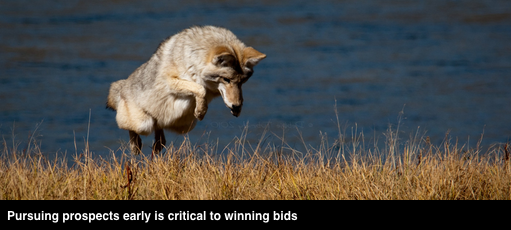There are seemingly countless tasks involved in responding to a competitive Request for Proposal (RFP). High performing teams will want to fine-tune their processes and execution in every area. But, for teams that aren’t there yet, this month we’ll cover five tasks to focus on in improving win rates.
The first task is to engage with the issuer before the RFP is issued.
Why Pre-RFP pursuit is critical
Bidders often lock up contracts pre-RFP by getting closest to the issuer’s key decision maker(s). This is common despite ostensibly transparent bid processes, especially when the front-runners are seen as equally qualified.
Effective pursuit happens before the RFP is issued. It aims to do two things:
- Build relationships: Buyers like to deal with people they know and trust—especially if the contract is for complex services delivered over many years. That’s why trusted advisors (as distinct from service providers) regularly win large bids on relationship alone, even when their offer isn’t objectively superior, based on features or price.
- Discover what really matters: RFPs often contain an “Our objectives” section—but it’s rarely insightful. Pre-RFP discovery builds deeper understanding of both the strategic purpose for the purchase and the evaluator hot button issues bidders need to address.
What to do
Ask yourself: Are we getting out in front of large pieces of business?
If you’re just learning about large opportunities when the RFP comes out—or, worse, weeks later—you need a pursuit strategy with these components:
- Research: Make a habit of scanning for future opportunities, both with current clients and new prospects. How you do this will depend on your business model and industry. Networking and Google alerts work well at Complex2Clear. Note: You can still jump on off-radar opportunities—the aim is to become more proactive over time.
- Alignment with the client team: If your prospects and clients are large organizations, work at building relationships at all levels in the chain of authority. If your company is large enough, create a client map and assign your team members to target individuals at similar levels. See this post on large prospect pursuit.
- Project discovery: In addition to building relationships, focus on gathering useable intelligence about the project, including its strategic purpose and what features and benefits will be most important to the evaluators. Ask team members to make notes at or right after meetings to capture the prospect’s own words whenever possible.
- Capture planning: Document pursuit results in a capture plan that can transition into a proposal strategy. Choose a framework and format for the capture plan (Word, Excel, PowerPoint) that makes it easy to share and update.
Start with an improvement plan
Transitioning from no pursuit planning to a robust and repeatable process takes time. The first step is to get buy-in from your sales structure and senior leadership. Then adapt the components above to your situation and identify first steps in an improvement plan.
Photo credit


